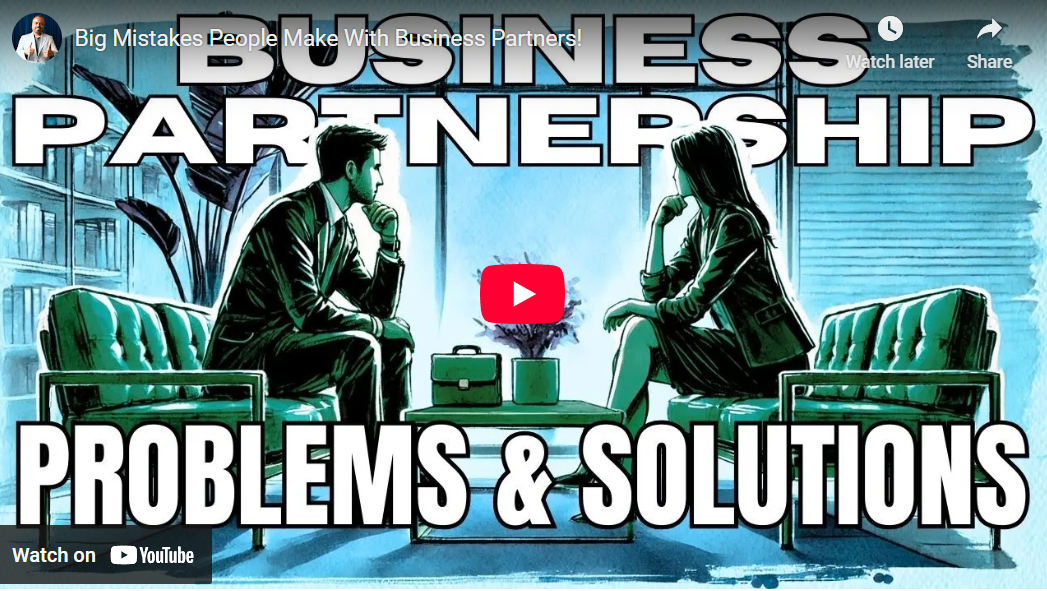Big Mistakes People Make With Business Partners!

🤝 Business Partnerships: What You MUST Know Before You Start One
Hey my friend,
Are you currently in a business partnership that’s feeling rocky?
Or maybe you’re thinking about starting one?
Before you make that leap—or leap further—into business with someone else, this is a must-read. Let’s dive into the real challenges of business partnerships and how to solve them before they cost you time, money, or relationships.
🚧 The Real Challenges of Business Partnerships
1. Clashing Decision-Makers
One of the biggest issues? Head-on collisions when making decisions.
If both partners have dominant, task-oriented personalities (think “driver” types), you’ll constantly clash over how things should be done. You both want control. You both want to lead. And that makes teamwork tough.
Solution:
Use a tool like the DISC profile to understand each other’s personalities before committing. You don’t need two drivers—you need complementary strengths.
2. Unequal Effort or Contribution
A common complaint:
“I’m doing everything. My partner isn’t pulling their weight.”
When profits are split 50/50 but the work isn’t, resentment builds. Whether it’s hours worked, leads generated, or value contributed—both partners must add something real.
Solution:
Set clear roles and responsibilities in writing. Specify who does what daily, weekly, and monthly. This prevents one partner from micromanaging the other—or worse, doing everything themselves.
3. Growth at Different Speeds
You may start a business together on the same page, but fast forward a year or two…
- One partner is learning, adapting, growing with coaching or mentorship.
- The other? Still stuck in the same place.
Now your visions and ambitions don’t align—and that’s a recipe for tension.
Solution:
Regular check-ins and future-planning sessions. Make sure you’re still aligned on business goals and personal development. And be honest: Is your partner holding you back?
📜 The #1 Rule: Define Everything in Writing
The only way to survive a partnership is by having everything spelled out:
- Who does what?
- Who has final say?
- What happens if someone wants out?
Don’t skip this step. A written agreement is not optional—it’s essential.
💡 Alternatives to Traditional Partnerships
Not ready to dive into a 50/50 business relationship? Good news—you have options:
Option 1: Equity Partnership
If you don’t have the budget to hire full-time help, offer profit-sharing instead.
Example:
You’re a great salesperson, but you’re weak in marketing and finance.
Bring on 2–3 people to support those areas. You keep 60% of the profit, and split the remaining 40% based on contribution.
✅ You stay in control.
✅ You build a solid team without upfront costs.
Option 2: Joint Venture
A joint venture partner can offer funding, tools, or strategic support. But they’re not involved in daily operations or decision-making.
✅ They’re a silent partner.
✅ You guarantee them a return, but retain full operational control.
This is great if you have a clear vision and just need a little help getting there.
🧠 The Smart Way to Choose a Partner
Don’t partner with someone just because:
- You’re friends
- They have money
- They’re “interested” in your idea
Instead, look for someone who:
- Has a different skill set
- Aligns with your values and vision
- Is committed to growing alongside the business
Remember: You’re not looking for a clone.
You’re building a complete team.
✍️ Final Thoughts: Plan Before You Partner
Before you sign any partnership agreement, ask yourself these questions:
- Do our personalities complement each other?
- Are our roles clearly defined?
- Are we equally committed to growth?
- Do we have different, but aligned, skill sets?
- Can we agree on who makes the final decisions?
If the answer to any of these is “no” or “I’m not sure”—pause and reassess.